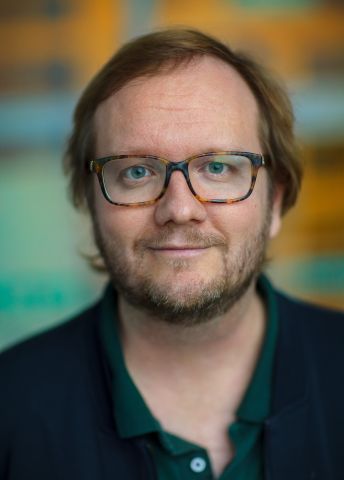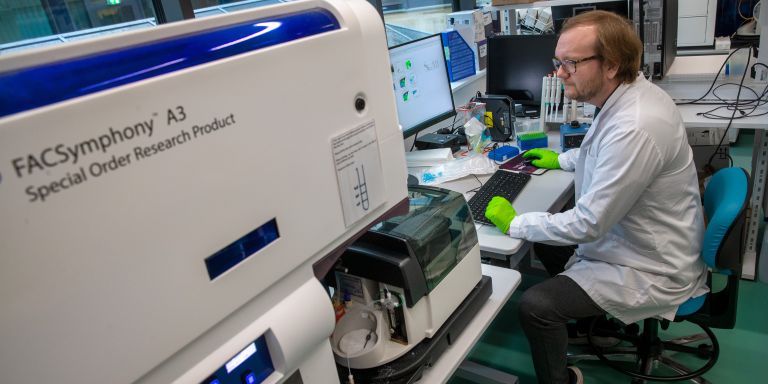
Marcus Buggert
Associate Professor of Immunology
Wallenberg Academy Fellow 2021
Institution:
Karolinska Institutet
Research field:
T-cell immunity against viral infections and cancer


Wallenberg Academy Fellow 2021
Institution:
Karolinska Institutet
Research field:
T-cell immunity against viral infections and cancer
T-cells are a type of immune cells existing in a number of variants. One of their abilities is recognizing and killing cancer cells and cells infected by a virus. Their ability to “remember” infectious agents and kill cells means they are variously called “memory cells” or “T-killer cells.”
Current knowledge about T-cells is mainly based on cells extracted from blood. Buggert, who is based at Karolinska Institutet’s Center for Infectious Medicine (CIM), has instead chosen to focus on T-cells found elsewhere in the body, including the lymph nodes. His findings show that the cells behave differently there and seem to have different functions.
“Only two or three percent of our T-cells are in the blood. Most of the rest are permanently located elsewhere in the body. And the blood is not usually the first place infections or tumors turn up,” Buggert says.
His research team uses multiple methods to study the cells, including single-cell analyses. It is now possible to rapidly sequence the DNA of an entire cell and see which genes are active and which are not. This enables the team to compare the activity in different cells.
“It was only a few years ago that techniques of this kind began to be used on a large scale. It has revolutionized our ability to make in-depth studies of the immune system,” Buggert explains.
He and his colleagues do not know precisely what T-cells in the lymph nodes do – only that they differ from those in the blood. Their analyses show that they do not produce the same proteins. Cells secrete proteins to regulate their activity and also to impact their surroundings.
“It seems that in addition to killing cells, they are also able to quickly enlist other immune cells to attack a target. We may be able to find a way of stimulating T-cells in tissues to make them even more effective.”
Buggert’s prime research example is the HIV virus, which infects a specific type of T-cells and kills them. The virus strikes at the very heart of the immune system, and without treatment, most patients contract life-threatening infections.
But HIV does not affect everyone in the same way. Some people appear to have T-killer cells that are better at controlling the virus.
“This is the holy grail of HIV research: If we can’t eliminate HIV completely, can we at least induce our immune system to control the virus? This would mean people didn’t have to take antiretroviral drugs. The approach is called “functional cure” – activation of the immune system so that other treatments are not needed.”
“I’m proud to be a Wallenberg Academy Fellow. The funding gives me time to think outside the box. And it’s great to meet other Fellows from other fields who share my curiosity.”
Buggert began researching HIV. His doctoral thesis dealt with immune system control of HIV infection. But at that time, his research was confined to immune cells in the blood. It was an eye-opener when he began to study tissues and found the cells there to be quite different.
Buggert’s team has now collected tissue samples from the gastrointestinal tract of HIV patients – those who have carried the virus for a long time and those who have recently been infected, and also from patients who seem to be able to control the infection. They have chosen this kind of tissue precisely because a large proportion of infected cells are usually found there. The researchers extract T-cells from the samples and study how they differ from T-cells in the blood of the same individuals. The aim is to figure out which processes are unique to the tissue cells. It is like creating a map of the disease to understand it better. It may be possible to find cell properties than can be used to produce vaccines, for example.
Those vaccines will not completely protect against infection; they will stimulate the immune system to prevent serious illness. They may also be efficacious against other viral diseases and forms of cancer for which immunotherapies are already used.
When Buggert started his postgraduate studies, he thought about applying to work at the WHO or UNICEF when he finished his PhD.
“I wanted to help people suffering from infections that are no longer a great concern in Sweden, such as HIV and tuberculosis. But I became so engrossed in my research that I continued along that path instead. It was probably a good thing. I think you should focus on what you’re really interested in. There are others who are better at helping people on the spot.”
He quickly realized that life as a researcher would give him ample scope to develop his curiosity and creativity.
“I think many researchers have a creative streak. Quite a few of my colleagues are skilled musicians or are good at cooking, which I think is interesting. It suggests that these people use their brains differently, not only the more structured parts of it. Perhaps research is something that gives us an outlet for that creativity.”
Text Lisa Kirsebom
Translation Maxwell Arding
Photo Magnus Bergström